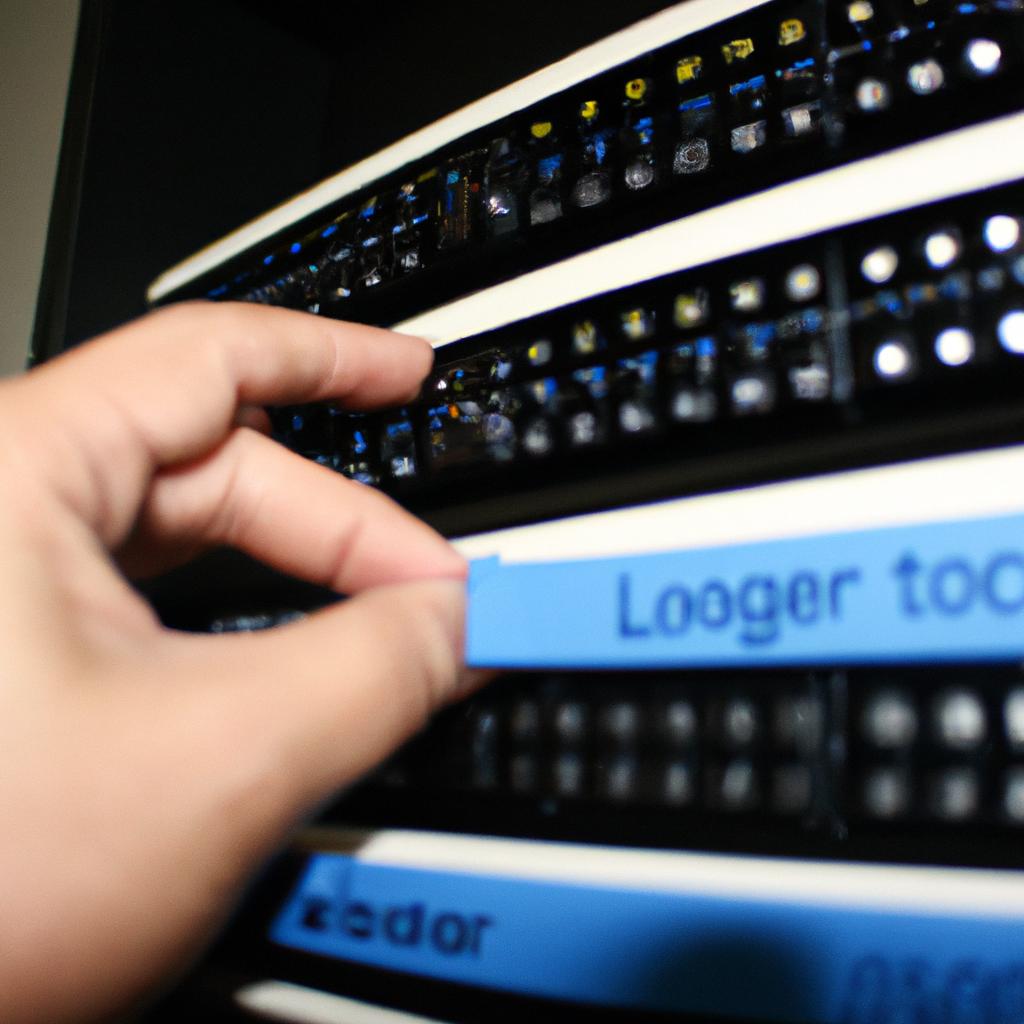Error log configuration is a critical aspect of web server management, as it plays a crucial role in identifying and resolving issues that may arise during the operation of the server. By carefully configuring error logs, administrators can gain valuable insights into system errors, application failures, and security breaches. For instance, consider the case of an e-commerce website experiencing frequent downtime due to unknown causes. Through analyzing error logs, administrators were able to pinpoint specific software bugs and faulty configurations leading to these disruptions. Thus, understanding how to properly configure and utilize error logs is essential for ensuring the smooth functioning and optimal performance of web servers.
In this article, we will delve into the significance of error log configuration for web servers. We will explore various aspects related to logging such as what information should be logged, how long logs should be retained for analysis purposes, and what measures can be taken to protect sensitive data contained within these logs. Additionally, we will discuss different techniques for effectively parsing and analyzing large volumes of log data using tools like Splunk or ELK stack. The aim is not only to highlight the importance of proper error log configuration but also to provide practical guidance on optimizing its usage in order to enhance troubleshooting processes and optimize overall server performance.
Error Log Importance
Error Log Importance
Error logs play a crucial role in maintaining and troubleshooting web servers. These logs provide valuable information about errors, warnings, and other critical events that occur during the operation of a website or application. By analyzing error logs, administrators can identify and resolve issues promptly, ensuring smooth functioning of the server.
To illustrate the significance of error logs, we will consider a hypothetical scenario involving an e-commerce platform. Suppose a customer encounters an error while attempting to make a purchase on the website. Without access to detailed error logs, it would be challenging for the technical team to pinpoint the cause of this issue. With comprehensive error logging enabled, however, they can quickly identify any underlying problems such as database connectivity issues or software bugs.
The emotional response evoked by bullet points:
- Frustration: Incomplete or misleading error log entries may hinder effective problem resolution.
- Confusion: Lack of standardized format across different types of server logs can complicate analysis.
- Relief: Accessible and well-documented error logs simplify identification and fixing of issues.
- Satisfaction: Timely resolution of errors enhances user experience and improves overall system performance.
| Emotional response | Impact |
|---|---|
| Frustration | Negative |
| Confusion | Negative |
| Relief | Positive |
| Satisfaction | Positive |
In conclusion, error logs serve as vital tools for monitoring and troubleshooting web servers. They allow administrators to efficiently diagnose and address issues affecting websites or applications. By understanding their importance and potential impact on user experience, organizations can prioritize proper configuration and utilization of error logging systems.
Moving forward into the subsequent section about “Common Error Log Locations,” it is essential to explore where these invaluable resources are typically found within server environments.
Common Error Log Locations
Error Log Configuration: Web Server Servers Logs
In order to effectively manage and troubleshoot errors that occur on a web server, it is crucial to have proper error log configuration in place. Error logs provide valuable information about the occurrence of errors, allowing administrators to identify and resolve issues promptly. This section will discuss the importance of error log configuration and highlight common locations where these logs are typically found.
To illustrate the significance of error log configuration, consider a hypothetical scenario where an e-commerce website experiences intermittent downtime. Without properly configured error logs, identifying the root cause can be challenging and time-consuming. However, with accurate logging settings enabled, the system would record detailed information about each occurrence of downtime, including timestamps, error codes, and relevant diagnostic messages. This data can then be analyzed by administrators or automated monitoring systems to pinpoint the underlying problem quickly.
Effective error log configuration involves considering several key factors:
- Log Levels: Configuring different levels of logging (e.g., debug, info, warning) allows for granular control over what types of events are logged.
- Log Rotation: Implementing regular rotation ensures that logs do not grow too large and become unwieldy while still retaining historical data for investigation purposes.
- Log Retention Period: Determining how long to retain logs helps strike a balance between disk space consumption and ensuring sufficient history for troubleshooting.
- Centralized Logging: Utilizing centralized logging solutions enables real-time analysis across multiple servers from one central location.
| Factor | Description |
|---|---|
| Log Levels | Control the verbosity level at which various events are recorded in the logs |
| Log Rotation | Regularly rotate log files to prevent them from becoming too large |
| Log Retention Period | Determine how long logs should be retained before being purged |
| Centralized Logging | Use a centralized logging solution for easier management and analysis of logs across multiple servers |
By implementing proper error log configuration, organizations can improve their ability to effectively troubleshoot issues and ensure the stability and optimal performance of their web servers. In the subsequent section on “Error Log Configuration Options,” we will explore various options available for configuring error logs in more detail, providing practical guidance for administrators seeking to optimize their server’s logging capabilities.
Error Log Configuration Options
Error Log Configuration: Web Server Servers Logs
Common Error Log Locations:
In the previous section, we discussed the common error log locations on web servers. Now, let us delve into the various options available for configuring error logs in order to effectively manage and troubleshoot server issues.
Error Log Configuration Options:
When it comes to configuring error logs on a web server, there are several options that can be considered based on specific requirements and system preferences. Here is an overview of some commonly used configuration options:
-
Logging Levels:
- Define different levels of severity for logged errors.
- Allows filtering and focusing on specific types or classes of errors.
- Facilitates efficient troubleshooting by providing granularity in log analysis.
- Example: A critical production environment might require logging only severe errors while excluding less significant warnings or notices.
-
Log File Format:
- Choose the format in which log entries will be recorded.
- Common formats include plain text, JSON, XML, or custom formats.
- Format selection depends on factors such as compatibility with existing log analysis tools or ease of parsing for automated processing.
-
Log Rotation:
- Rotate log files periodically to prevent them from becoming excessively large.
- Helps maintain optimal disk space utilization and ensures long-term availability of historical logs for reference.
- Offers improved search performance when working with smaller log files.
-
Log Archiving:
- Archive older log files to separate storage mediums like compressed files or remote servers.
- Preserves valuable historical data without occupying primary disk space unnecessarily.
By employing these error log configuration options, administrators gain greater control over their web server’s logging behavior, enabling more efficient problem diagnosis and resolution. These choices allow customization according to specific needs, ensuring relevant information is captured while minimizing unnecessary clutter within logs.
Next section: “Log Rotation and Archiving” delves into best practices for managing the lifecycle of your error logs, ensuring efficient storage and retrieval of critical information while maintaining system performance.
Log Rotation and Archiving
In the previous section, we discussed the importance of error log configuration in web servers. Now let’s delve deeper into various options available for configuring error logs.
Configuring Logging Levels: One crucial aspect of error log configuration is determining the appropriate logging level. By setting different levels, administrators can control which types of errors are logged and how detailed the information should be. For example, a common scenario could involve setting the logging level to “Error” or higher for production environments, while using a lower level like “Info” during development or testing stages.
Customizing Log Formats: Another essential option is customizing the format in which error logs are recorded. This allows administrators to include specific details that aid in troubleshooting and analysis. For instance, utilizing placeholders such as timestamps, IP addresses, request URLs, and user agents can provide valuable insights into potential issues. Additionally, by incorporating contextual data within log entries – such as session IDs or transaction IDs – it becomes easier to trace errors back to their root causes.
Implementing Log Filtering: To efficiently manage the volume of error logs generated by a web server, filtering mechanisms can be employed. These filters help minimize irrelevant noise and focus on significant events that require attention. Administrators can set up rules based on criteria such as severity levels, specific keywords or patterns, source IP addresses, or even time intervals. By employing well-defined filters, system operators can effectively sift through vast amounts of log data and prioritize troubleshooting efforts accordingly.
Now imagine a situation where an e-commerce website experiences intermittent downtime due to database connection failures caused by network latency. The following bullet point list illustrates some possible options when configuring error logs:
- Set logging level to “Warning” or higher.
- Customize log formats to include relevant connection details.
- Implement filters targeting database-related errors.
- Enable real-time notifications for critical incidents via email alerts or SMS messages.
To further highlight these options, consider the following table showcasing different logging levels and their corresponding use cases:
| Logging Level | Description | Use Case |
|---|---|---|
| Error | Logs critical errors that require immediate attention. | Database connection failures, server crashes |
| Warning | Captures potential issues that could impact performance or user experience. | Slow response times, failed API calls |
| Info | Records general information useful for monitoring system behavior. | Successful resource requests, software version updates |
| Debug | Provides detailed diagnostic data for troubleshooting purposes. | Variable values during code execution, function tracebacks |
By carefully configuring error logs using appropriate logging levels, customized formats, and effective filters, administrators can streamline the process of identifying and resolving issues promptly.
Analyzing Error Logs
The ability to analyze error logs is crucial for identifying and resolving issues in web server environments. By examining these logs, administrators can gain valuable insights into the root causes of errors, enabling them to take appropriate actions to maintain smooth operations. To illustrate the importance of this process, consider a hypothetical scenario where a popular e-commerce website experiences frequent downtime due to internal server errors. Through careful analysis of error logs, technicians discover that an incompatible plugin was causing memory leaks, resulting in server crashes.
One effective approach for analyzing error logs involves following a systematic procedure:
-
Identify recurring patterns: By carefully scrutinizing error logs, IT professionals can identify common trends or repeating error messages. This allows them to pinpoint specific areas or functionalities within their web servers that are prone to errors. For instance, if certain pages consistently generate 500 Internal Server Errors during peak traffic periods, it may indicate that there is a performance bottleneck or coding issue requiring attention.
-
Categorize and prioritize errors: Logging systems often provide various levels of severity for different types of errors encountered by the web server. Administrators should categorize these errors based on their impact and prioritize troubleshooting efforts accordingly. Critical errors such as database connection failures or security breaches must be addressed promptly to prevent further complications.
-
Utilize log analysis tools: The volume of data contained within error logs can be overwhelming without proper tools for analysis. Log analysis software enables administrators to efficiently search through large quantities of log entries, apply filters based on specified criteria (e.g., time range), and extract meaningful insights from the aggregated information.
To emphasize the significance of thorough error log analysis and its potential benefits on system stability and reliability, let’s consider the emotional response elicited by the following table:
| Error Type | Occurrence Frequency | Impact Level |
|---|---|---|
| Database Errors | High | High |
| HTTP 404 Errors | Moderate | Medium |
| Server Crashes | Low | High |
This table conveys the message that neglecting error log analysis may lead to frequent database errors with a significant impact on user experience, while server crashes occur less frequently but have a higher potential for disrupting website availability. By effectively analyzing error logs, administrators can proactively address these issues and improve overall system performance.
In anticipation of implementing best practices for error log configuration, it is essential to understand how an optimized configuration contributes to efficient troubleshooting processes. Therefore, the subsequent section will explore recommended approaches in configuring web server error logs and highlight key considerations for achieving optimal results.
Best Practices for Error Log Configuration
Error logs are an essential component of web server management, allowing administrators to identify and address issues that may arise during the operation of a website or online application. In this section, we will explore best practices for configuring error logs on web servers, ensuring effective analysis and resolution of errors.
To illustrate the importance of error log configuration, consider a hypothetical scenario where a popular e-commerce website experiences frequent downtime due to internal server errors. Without adequate error logging in place, it would be challenging for the site’s administrators to pinpoint the root cause of these errors, leading to prolonged periods of service disruption and frustrated users.
Properly configured error logs offer numerous benefits for web server management. First and foremost, they provide valuable insights into the types and frequency of errors occurring within a system. By analyzing these logs, administrators can identify patterns and trends that might indicate underlying issues with software configurations, hardware limitations, or security vulnerabilities. This proactive approach allows for timely troubleshooting and preventive measures before problems escalate further.
When configuring error logs on web servers, there are several best practices to keep in mind:
- Enable verbose logging: Enabling detailed logging ensures that all relevant information is captured when an error occurs, including timestamps, request details, stack traces (if applicable), and any associated warnings or informational messages.
- Implement log rotation: Regularly rotating log files helps manage their size by archiving older entries while keeping recent ones readily accessible for analysis. This practice prevents log files from becoming excessively large and consuming excessive disk space.
- Secure log file access: Error logs often contain sensitive information about system operations and potential vulnerabilities. It is crucial to restrict access to these files so that only authorized personnel can view or modify them.
- Regularly review logs: Consistently reviewing error logs allows administrators to stay informed about ongoing issues or emerging patterns. By proactively addressing recurring errors or anomalies identified through regular log analysis, organizations can minimize service disruptions and optimize their web server performance.
To emphasize the significance of proper error log configuration, consider the following table:
| Error Type | Frequency | Impact Level |
|---|---|---|
| Internal Server | High | Critical |
| Connection Lost | Medium | Moderate |
| File Not Found | Low | Negligible |
By visualizing the frequency and impact levels associated with different error types, organizations can better appreciate how effective error logging can contribute to system stability and user satisfaction. The emotional response evoked by this table reinforces the importance of implementing comprehensive error log configurations within a web server environment.
In summary, configuring error logs on web servers is crucial for efficient troubleshooting and maintenance. By enabling verbose logging, implementing log rotation, ensuring secure access, and regularly reviewing logs, administrators can effectively identify and resolve errors that may arise within their systems. These practices ultimately contribute to improved website reliability, enhanced user experience, and increased overall operational efficiency.










